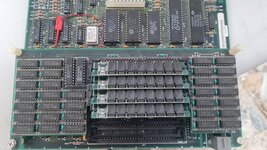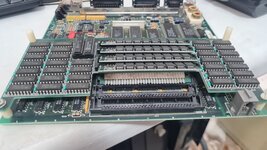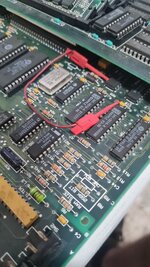More SuperMac history and places you can no longer visit.  Here is a rough outline:
Here is a rough outline:
More SuperMac history and places you can no longer visit. Here is a rough outline:
950 N. Rengstorff, Mountain View:
In 1987, SuperMac was located at 950 N. Rengstorff in Mountain View. It was just down the street from great burrito joints that also no longer exist -- like La Bamba (near Middlefield) and also Caramba! (on Mary Ave.). During that time, SuperMac sold Enhance, DF20, XP20, XP40 and ... SuperRam 2 and SuperRam 4 (earlier MacPlus memory upgrades). I think the XP40 was $2999.00. The early RAM upgrades that they soldered were for the 128K Macs. Also, they sold SuperSpool and SuperLaserSpool. In 1987, SuperMac also opened an office in London/UK as the drive and software product lines began to expand.
295 S. Bernardo Ave., Sunnyvale:
By late '87/early '88, SuperMac had moved to 295 S. Bernardo in Sunnyvale - with further expansion of the XP drive line and the birth of the video card business with the original Spectrum/8 and ColorCard boards, plus adding the DataStream/DC2000 tape drives and large-format Bernoulli drives (XP60+B), partnering with Levco on hardware expansions, partnering with Dantz for DiskFit and Retrospect, releasing Sentinel, etc. -- all of this was after they had become part of SMS (Scientific Micro Systems). Unfortunately, SMS declared bankruptcy in early 1988. But, SuperMac saved themselves with a management-led buy-out to prevent being sucked into the Chapter 11 vortex. The acquisition by SMS was originally based on synergy with the drive business and use of SMS controllers (MFM/SCSI) in the DataFrame product line. During this era, MiniScribe was famously shipping bricks instead of hard drives (the XP30 used a MiniScribe mechanism).
 485 Potrero Ave., Sunnyvale:
485 Potrero Ave., Sunnyvale:
After the buy-out/escape from SMS and continued growth, SuperMac moved to 485 Potrero Ave. in Sunnyvale. SuperMac grew exponentially, rebranded itself as a "High-End Graphics Subsystems Company," easily surpassed a $100M valuation, expanded all the product lines, especially video (including video acceleration + DSP boards) and mass storage (including releasing an optical drive). This era also included the creation of all of the video compression and capture hardware/software, including products based on the C-Cube CL550B (SuperSqueeze), YUV-based VideoSpigot, ScreenPlay, QuickTime Support, Digital Film, Cinepak CODEC, and what eventually became Adobe Premiere (SuperMac ReelTime, aka/codename "Scrunch"). The print/pre-press products also came into being -- the dye sublimation printer, partnership with Tektronix (TekColor), SuperMatch, SuperMac credit in "From Alice to Ocean," and the (I think) RS3000-based postscript RIP. SuperMac's IPO happened in May 1992 while at Potrero.
215 Moffett Park Dr., Sunnyvale:
Post-IPO -- in late 1992 -- SuperMac moved to 215 Moffett Park Drive in Sunnyvale (near Mathilda/237). But...possible clues that things might eventually go haywire as Apple continued to encroach into the video/monitor space may have included spending $100K to re-paint the foyer with a multi-colored spectrum design. SuperMac merged with Radius in 1994 in an $80M stock swap (and attempt to remain relevant in a shrinking market), Radius moved to Moffet Park, and then, despite their Promethean evolutionary arcs at the Dawn of Macintosh, great products and the engineering horsepower of the Dynamic Video Duo, Apple- and Moore's Law-driven pressure of integrated, high-resolution video in machines with very fast CPUs (plus other market factors) led to rapidly-shrinking revenue and eventual corporate collapse.
[Mozart "Requiem" plays quietly in the background as a banner with a brilliant red "S" flutters in the winds of a distant time.]







